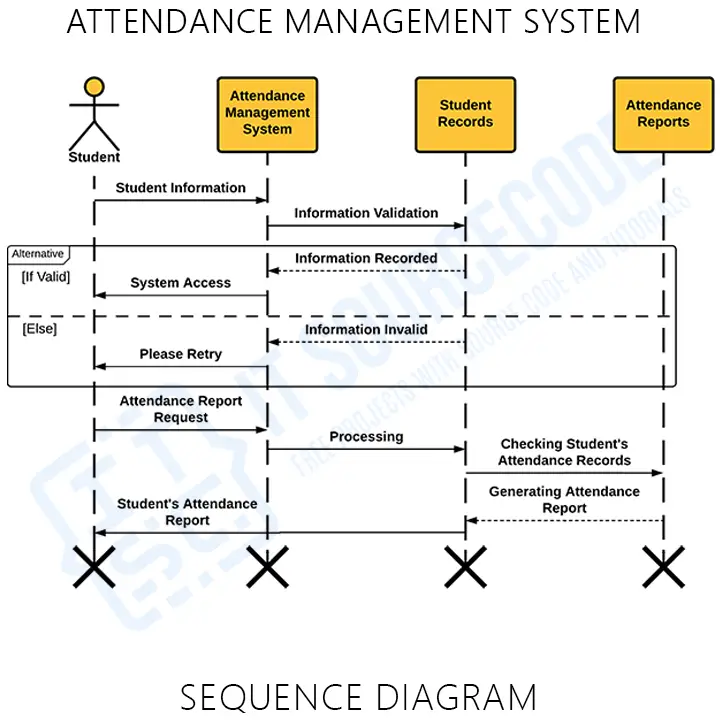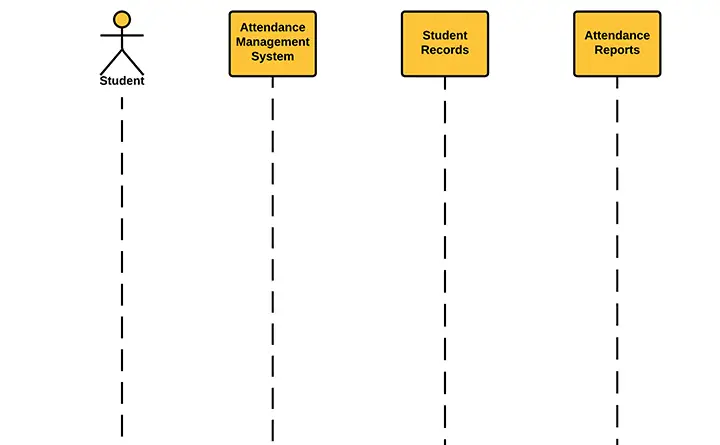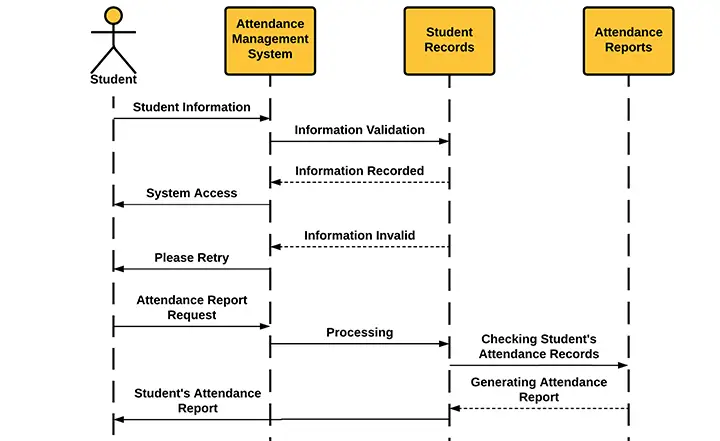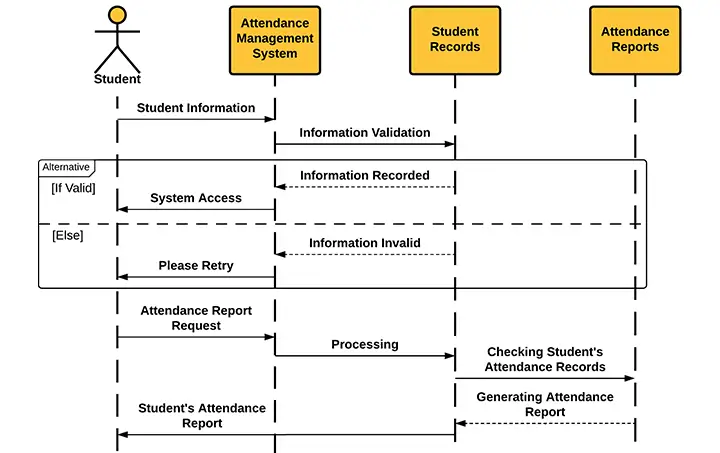The Sequence Diagram for Attendance Management System describes the series of interactions that occur with the objects when performing the system’s process.
A sequence diagram is one of the UML models used for presenting the workflow, sequence of messages, and interactions within the Attendance Management System.
What is an Attendance Management System?
Employee working hours, time off, break time, login time, departures, and attendance are all tracked by an attendance management system. The system not only keeps correct records of attendance and absences but also saves HR and office personnel time and money on attendance management tasks.
What is UML Sequence Diagram?
A sequence diagram is a useful tool for documenting a system’s needs and fleshing out its architecture. Because it depicts the interaction logic between the items in the system in the time order in which they occur, the sequence diagram is quite valuable.
Sequence Diagram for Attendance Management System (Illustration)
The designed sequence diagram for student attendance management system gives you the exact scenario when the project is in use. This design presents the actual sequence of events and interactions between the user and the project. It uses symbols to represent the included objects and their roles in the attendance management system sequence diagram.

The illustration is based on the main process of the attendance management system. It can still be modified and added with your desired functions and scenario. It is more effective and efficient to manage and monitor the attendance of employees through the attendance management system.
Sequence Diagram for Attendance Management System (Pdf)
You may download the Sequence Diagram for Attendance Management System PDF by clicking the button below. It has the full details and discussion of the system’s sequence diagram. You can also modify its content to complete your project requirements and needs.
Steps in Developing Sequence Diagram
Time needed: 10 minutes
Here’s the complete guide and steps in developing and designing your sequence diagram for the attendance management system.
- Finalize the purpose of the project
The first step in doing your sequence diagram is to finalize what your project is all about. The attendance management system portrays the idea of monitoring and checking employee attendance. Then this idea will give you other initiations on what to include in the project.
- Place your users or objects
The project users in the sequence diagram will always be based on your targeted users. You can create a design for each of your users or put them all in one design. Just be mindful of having a clear and precise illustration.

On the other hand, the object is represented by a rectangle with the object’s name underlined. The object name, the object name, and its class, or only the class name can all be used to name an object (anonymous object).
The sequence diagram depicts a group of objects connected by lifelines as well as the messages they exchange over time during the interaction. - Add the lifelines in each user and object
A lifeline represents each instance of interaction. As it moves downhill, it represents the passage of time. Broken vertical lines show the next events that happen to an object during the charted process. A named rectangular shape (object) or an actor symbol is used to start Lifelines.

The lifeline sequence diagram is symbolized by a broken line connected to its head (object) that represents the lifetime of the object. - Structure the sequence of messages (interaction)
A message is a representation of communication between objects or between an object and its surroundings. An event, a triggered operation, or a primitive operation are all examples of messages. A message in the metamodel denotes a certain sort of communication.

In UML diagrams, messages are represented as labeled arrows, with the arrowhead indicating the call’s direction. When a message is sent to an object, the name of the method being called on the receiving object is indicated in the text associated with the message. - Add alternatives (if needed)
When a scenario needs to choose between two or more message sequences, the alternative combination fragment is employed. It represents the logic of “Otherwise, if. One way for distinguishing which fragment is which “operator for fragments” is to put “alt” in the name box of the frame, also known as the “frame name box.

Different process conditions are denoted by the term “alt. Only one of the options will be implemented. The term “opt” means a workflow phase that can be skipped. - Add the X symbol as the lifeline end
When the object’s lifeline is completed, you can add an X to the end of it to indicate that it has been destroyed. A rectangle represents a recurrence or loop in a sequence diagram.

Conclusion
You need to know the diagrams used to design and develop the Attendance Management System. Because you cannot perfectly create a fully-functional system without it. But if you create this sequence diagram, you will know the series of processes and interactions that implies the system’s function. A sequence diagram guides the programmers with the system’s behavior through its’ interaction diagram.
Related Articles
- Credit Card Processing Sequence Diagram
- Sequence Diagram for Course Registration System
- Sequence Diagram for Face Recognition Attendance System
- University Admission Management System Sequence
- Online Food Ordering System Sequence Diagram
Inquiries
If you have inquiries or suggestions about Sequence Diagram for Attendance Management System, just leave us your comments below. We would be glad to hear to concerns and suggestions and be part of your learning.






